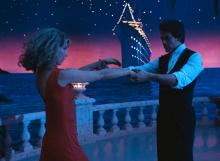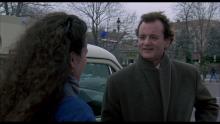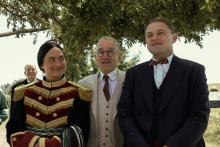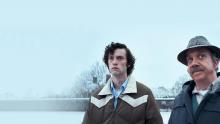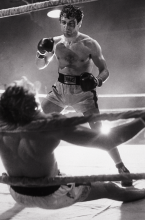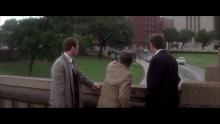The following notes on Francis Coppola's One from the Heart were written by Nimish Sarin, PhD student in the Department of Communication Arts at UW Madison. One from the Heart Reprise, a newly revamped version supervised by Coppola himself, will screen on Saturday, February 10, at 7 p.m., in the Cinematheque's regular venue, 4070 Vilas Hall, 821 University Ave. Admission is free!
By Nimish Sarin
Coming off the commercial success of Apocalypse Now (1979), MGM had initially offered $2 million to Francis Ford Coppola to direct his proposed follow-up, One from The Heart. Instead, Coppola decided to handle the project at his own company, Zoetrope Studios. Working with screenwriter Armyan Bernstein, Coppola changed the story from a romantic comedy to a musical and shifted the setting from Chicago to Las Vegas. Reportedly spending over $4.5 million for elaborate matte-painted backgrounds and a miniature recreation of Fremont Avenue on the soundstages of his Zoetrope Studios, Coppola, along with production designer Dean Tavoularis, created a regal replica of the glitter gulch. The lavish sets were captured by the dynamic camera of legendary cinematographer Vittorio Storaro (working in the traditional Academy aspect ratio of 1.37:1), bathing the bustling buildings in candy-colored neon lights that somehow seem to out-Vegas the real thing. In addition to the glitzy visual track, Coppola enlisted Tom Waits to create the Oscar-nominated soundtrack for the faux-musical. With accompanying vocals from Crystal Gayle, Waits provided jazzy mournful ballads in his trademark raspy timbre that often worked to fill in the gaps of what is left unarticulated, or perhaps, unvoiced.
To oversee this ambitious production, Coppola also employed a pioneering technological process, termed “electronic cinema”, where he ran production not on set, but from a high-tech trailer (called “Starfish”) equipped with state-of-the-art monitors and video editing equipment. Recording storyboards and rehearsals on videotape to pre-visualize the film, these stand-ins were later replaced by principal photography in real-time that was captured on videotape from the 35mm film camera using a special coding process, removing the need to look at rushes (a precursor to “video-assist” so to speak). Coppola, ever the forward thinker, saw this technology as revolutionary and thought it would change the process of post-production permanently. What’s ironic about One from the Heart is that these elaborate resources and new technologies were ultimately in the service of a simple, modest story.
One from the Heart follows Hank (Fredric Forrest) a misanthropic mechanic, and Frannie (Teri Garr), a wistful travel agent, whose relationship hits the skids on the eve of their fifth anniversary (which happens to fall on the 4th of July). After a heated argument sends them on their separate ways, both spend the weekend indulging in rebound romances: he meets ethereal circus performer Leila (Nastassja Kinski) and she meets dashing waiter/cocktail singer Ray (Raul Julia). After an amorous weekend with their new flings, both lovers reconsider the state of their long-term relationship, and, in a classic romantic climax, Hank chases after Frannie through McCarran Airport (another miniature recreation) hoping for one last shot at love.
Opening in February of 1982, the film was an immediate critical and commercial failure, failing to earn even a million dollars on its initial run. This investment ultimately led to years of financial turmoil and legal trouble for Coppola and ended with both him and his company Zoetrope filing for Chapter 11 bankruptcy in 1992. Contemporaneous critics lambasted the film for its obscene spending yet diminishing narrative return, although usually complementing the glamorous visuals themselves. Pauline Kael decried the film for its privileging of auterist excess over narrative depth stating that Coppola “didn't think out the character relationships but simply piled visual ideas…until the movie became so jewel-encrusted that the story practically disappeared from sight.” Similarly, Roger Ebert called it “a ballet of graceful and complex camera movements occupying magnificent sets” but ultimately lamented that the characters and story got lost in the process.
While the film received a slightly better response on its re-release in 2003 (with minor trims and changes), the uneasiness with its grand stylization but “wafer-thin” story persisted. The version being screened at the UW Cinematheque is a new 4K restoration titled One from The Heart Reprise that was overseen by Coppola himself and sourced from the original camera negatives. Despite a run time that comes in almost fifteen minutes shorter than the original cut, Coppola also incorporated roughly thirteen additional minutes of new footage sourced from the same negatives. “This new version is an improvement in many ways, and I am proud of what was achieved with One from the Heart Reprise” remarks Coppola, “despite the disruption it caused in my dreams for American Zoetrope,” he adds.
Whether read as an allegory for the malaise that set in during the new Reaganite America (we hear Hank remark that in America “there are no more secrets, it's phony tinsel, it's phony bullshit man. Nothing's real!”), Coppola’s take on a classic lover’s spat, or as yet another example of a New Hollywood director both reviving and reconfiguring the Golden Age Hollywood musical (see, for example, Scorsese’s New York, New York or Bogdanovich’s At Long Last Love), One From The Heart is first and foremost a stylistic tour de force. Employing an almost blinding cinematic excess, the stock characters and predictable narrative tropes become a broad canvas on which Coppola unleashes his phantasmagoric flourishes. Utilizing trick photography, superimpositions, rear projection, matte backgrounds, and abrupt, dramatic changes in lighting between sequences, Coppola seems to privilege, rather than eschew, the artifice of Hollywood production. In this way, the setting of Las Vegas becomes a perfect synecdoche for his larger project; an uncurbed cinematic play of light and shadow is apt for the land of glistening neon lights and uninhibited vice.
However, towards the end of the film, as Frannie nears a life-changing decision, she hears Hank emerging behind her, pleading with her to come back to him. As the camera tries to capture Hank from within a bustling throng of people, Frannie tells him to stop. Undeterred, he continues to beg, eventually breaking out into a rendition of country standard “You Are My Sunshine”. For once, we are not greeted with Tom Waits’ guttural yet melodious voice. Instead, we only hear Hank, who serenades Frannie in a warbling, off-pitch rendition. The artifice is lifted, the proscenium revealed, and finally the ineffable is articulated, if only for a minute. It is debatable if the romanticized mawkishness combined with the stoic pessimism at play here ultimately works or not, if the bid to turn a banal tale of ordinary romantic rupture and reconciliation into an aesthetically audacious experiment succeeds. It is, however, undeniable that Coppola’s unabashed and utopian, if ultimately doomed production, is worth one’s time.

